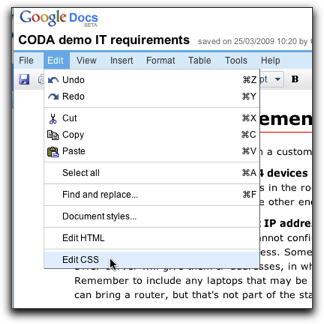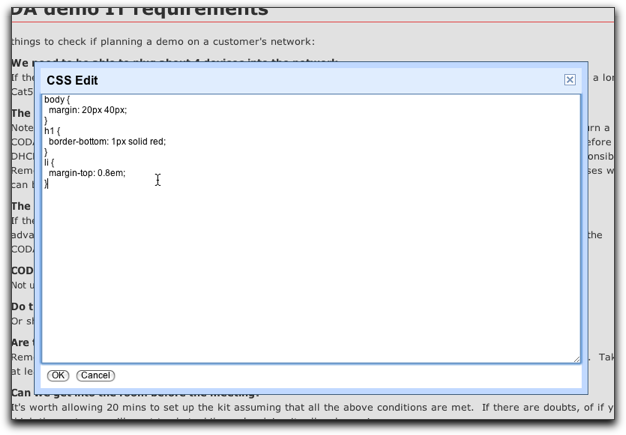Last week a British vehicle set a new land speed record for wind-powered vehicles. 126.1mph.
Not the easiest thing to park at Waitrose, perhaps, but very pretty.
Last week a British vehicle set a new land speed record for wind-powered vehicles. 126.1mph.
Not the easiest thing to park at Waitrose, perhaps, but very pretty.
From the RosenblumTV blog:
Media Life reports this week that the average American now spends 8.5 hours a day staring at some kind of screen, whether its television, computer or cellphone.
…
This means that screenwatching has now become the number one human activity, surpassing even sleep. We will spend more of our lives staring at screens than doing anything else.Screenwatching has become the seminal and defining act of our culture.
I wonder what this will look like in three years’ time…
I’m a huge fan of Google docs – especially where several people need to collaborate on a document. But sometimes the formatting capabilities can be a little restricting – margins, line spacing, etc – you have little control over those.
Or so I thought, until this morning I discovered the ‘Edit CSS’ menu option:

With a little bit of CSS you can change the appearance in all sorts of ways. My needs are mostly simple, though.

Similarly, you can edit the HTML in various ways. I needed a line break as opposed to a paragraph break. Right click and you can Insert HTML at Selection. Type <br /> and you’re done.
I hope they teach raw HTML and CSS in schools these days. It’s the punctuation of the future. Not that they teach punctuation any more…
“I would show you this on my laptop”, said a visitor to our company recently, “but it would take forever to boot up”.
And I realised how long I’d been living in a Mac world: for the last eight or nine years I’ve had a laptop where you open the lid and start typing pretty much immediately. (Camvine is an all-Mac shop except for the servers, which are Linux, and stay on all the time anyway.)
The slow start-up (and even rather painful resume-from-suspend) that people in the Windows world often experience has led to some modern machines having a minimal Linux installed alongside Windows, so you don’t have to wait for your entire world to load if you just want to check something quick on the web. Chris Nuttall, writing in the FT techblog, seems to be quite impressed with Presto.
My ageing Nokia E61 was, in many ways, an excellent phone – it was my TomTom, my Blackberry, a pretty good web browser, but it was starting to have occasional hiccups, and ‘out of memory errors’ once I started syncing over 1000 contacts to it from my Mac. It was time for a replacement, and an iPhone would be the natural thing for someone who loves the iTouch as much as I do, but I’m in the twilight zone at the end of a service contract and to switch suppliers would be expensive at present; besides, I won’t be surprised if there’s a new iPhone in the summer.
So I opted for a second-hand E71 from eBay, having read rave reviews for it, and I have to say it’s a very nice device. It’s familiar, being a successor to the E61, and adds a reasonable 3MP camera, a GPS – even, I discovered this morning, an FM radio – all in a much smaller and sexier package.
What many Nokia smartphone users may not know is that Nokia give out some quite interesting bits of software from time to time. Nokia Messaging makes up for the fact that I can’t install Blackberry Connect on this device, for example.
My only real disappointment was with the battery life, which was poor even by 3G smartphone standards. But even there, help was at hand in the form of the Nokia Energy Profiler – a very cool tool which can monitor all sorts of things.

If you leave this running as a background process you can try making adjustments to your configuration to see the effect. The peak in the power consumption shown on the screen was when I turned the camera on, for example.
Through this I discovered that switching off HSPDA – leaving me with 3G but not ‘3.5G’ – would give me a substantial cut in power usage, and hopefully extend my normal battery life beyond a day… we’ll see how it goes!
Update: Well, it didn’t notably extend my battery life. But what did make a difference was switching the ‘Packet data connection’ setting from ‘When available’ to ‘When needed’. Now I get a whole day and a bit more.
I got an email from Richard Branson this morning. Well, all right, I don’t think he personally sat down and typed it, unable to resist the urge to tell me about my particular cable modem connection, but he seemed pretty excited. Here’s an extract:
With the launch of our 50Mb broadband this year, the possibilities are virtually limitless. Who knows what speeds we’ll be able to bring to you in the future. But rest assured – since you’re on the fibre optic network, you’re on the right network.
With fibre optic technology the possibilities are virtually limitless.
On top of almost infinite speeds, there’s the simply brilliant things that only fibre optic broadband brings. Right now, you’re already getting unlimited downloads and free internet security. But we’re about to bring you more.
and he goes on to talk about backups, file-sharing and so on.
All this is possible thanks to the power of fibre optic broadband.
What amuses me is the claim that things like ‘free internet security’ and ‘backups’ are only possible over fibre-optic networks, especially when the cable that comes into my house is quite clearly made of copper. I suppose their point is that all those bits of copper connect in the end to a fibre backbone, but isn’t the same true of DSL? I guess that a truthful statement might be:
All this happens a bit faster thanks to the fact that our fibre/copper transceivers are placed closer to your premises than most of our competitors’ and we use coax rather than twisted-pair for the last bit.
But that wouldn’t have the same marketing punch, would it?
Anyway – this rings a little hollow at the moment. I’ve been a happy Virgin Media customer for many years. The service (which they bought from NTL) has been fast and reliable… until a few months ago when things seemed to get somewhat wobbly. And in the last couple of weeks we’ve had to reboot our cable modem rather too often for comfort. Reports of VM’s experimentation with traffic shaping may or may not have anything to do with this, but it’s not just my connection – in the office we’ve gone as far as getting an ADSL line installed to see if that gives us a better connection.
The great thing about ADSL, for all its technical limitations, is that it’s a more open market. Once the BT man had visited to connect up the wire, we had a choice of who would actually provide the broadband service. It may be a bit slower, but it should be more predictable – we could call up small companies where you could speak to someone who knew about contention ratios, and the effect that different latencies would have on our VOIP codecs. The experiment starts next week, so it’ll be interesting to see how it goes.
But in our case it may prove that a choice of informed, personal support services was the disruptive technology that even the amazing fibre optic network failed to deliver…
 My friend Ray Gordon recently gave me one of the most useful iTouch/iPhone hints I’ve had in some time. If you already know this, it is blindingly obvious, but if you don’t, you definitely want to!
My friend Ray Gordon recently gave me one of the most useful iTouch/iPhone hints I’ve had in some time. If you already know this, it is blindingly obvious, but if you don’t, you definitely want to!
On the iPhone keyboard, you can tap the shift key to switch to caps, and the symbol/numeric key to switch to the layout that includes commas, hypens, numbers etc. But did you know that you can touch those keys and then slide your finger to the character you want? When you release, the keyboard reverts back to the mode it was in before. So if you want, say, to insert a hyphen or an apostrophe in the middle of a word, you need just one click-and-slide, rather than three clicks.
Try it and you’ll never look back!
Google have announced, but not yet launched, Google Voice, which is an expansion of the GrandCentral service they purchased a couple of years back. Think of it as a cross between your company phone exchange and Google Mail.
I have a GrandCentral account – seldom used at present, as it’s very US-centric. But it gives me one US phone number which I can choose to manage in many different ways through a convenient web interface – I can, for example, redirect it to a friend’s house if I’m staying with them, or to a softphone, or to a US mobile, or have it ring all of the above and email me a voicemail message if nobody answers any of them.
It’s a great service, and GrandCentral users have worried what would become of it since it passed into Google’s hands. So I’m pleased to hear that it’s being reborn – I hope, and expect, they will now have the resources to make it more international.
And I can’t help wondering if this might be a very key component of Android-based phones in future.
I’m about half-way through Ben Goldacre’s splendid book ‘Bad Science’, which talks about clinical trials, homeopathy, the subtleties of the placebo effect, the supposed benefits of antioxidants, and a range of other topics, and does so in a most enjoyable way. He exposes some of the real science, and some of the nonsense, behind what is reported in the media.
Ben is a doctor who works for the NHS, has a column in The Guardian, and a web site at badscience.net. To get a feel for his work, have a look at his analysis of some recent feel-good reports in the papers and, worryingly, in Parliament. He begins:
“”Seven hundred British troops seized four Taliban narcotics factories containing £50m of drugs”” said the Guardian on Wednesday. “”Troops recovered more than 400kg of raw opium in one drug factory and nearly 800kg of heroin in another.”” Lordy that is good. In the Telegraph, British forces had seized “”£50 million of heroin and killed at least 20 Taliban fighters in a daring raid that dealt a significant blow to the insurgents in Afghanistan.”” Everyone carried the good news. “”John Hutton, defence secretary, said the seizure of £50m of narcotics would ‘starve the Taliban of funding preventing the proliferation of drugs and terror in the UK’.””
Well.
And then he looks at the real numbers. Read the post here.
Michael took some great photos of the Counterfeit Guest launch party. Thanks Michael!
© Copyright Quentin Stafford-Fraser
Recent Comments